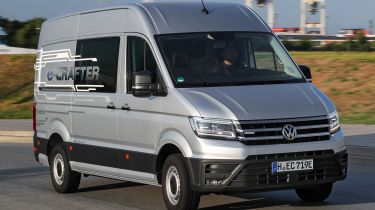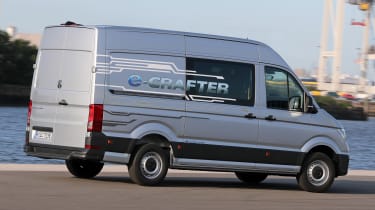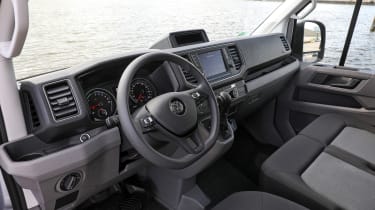Volkswagen e-Crafter review
Volkswagen joins the growing large electric van ranks with its electrified e-Crafter

The VW e-Crafter combines the great drive and user-friendliness of the diesel Crafter panel van with the zero-emissions electric drive that first-mile urban delivery companies will need to continue making deliveries in low emissions zones. It's easy to get on with and comfortable to drive, but it's still a niche choice that caters for a very specific niche in the large van market. If you're a fleet manager that can make the sums work for your business, then it's well worth considering.
With the roll-out of diesel bans and low emissions zones in urban environments across the globe, service industries are going to need zero-emissions delivery vehicles. And manufacturers are turning to their large vans to provide the solution. Hot on the heels of the Renault Master ZE and the forthcoming Mercedes eVito and eSprinter models, Volkswagen has launched the e-Crafter, an all-electric version of its largest van.
The e-Crafter follows a similar template to its rivals, as it uses existing electric vehicle technology to produce a zero-emissions commercial vehicle for first-mile deliveries and other businesses that need to access locations within potential zero-emissions areas. But as the e-Crafter was developed at the same time as the diesel version, the Crafter platform has been optimised to accommodate its EV running gear.
Used - available now

2023 Ford
Focus
14,538 milesManualPetrol1.0L
Cash £17,087
2023 Jaguar
E-PACE
20,181 milesAutomaticDiesel2.0L
Cash £24,287
2021 BMW
iX3
21,991 milesAutomaticElectric
Cash £26,787
2021 MINI
Cooper Electric
11,207 milesAutomaticElectric
Cash £12,387Under the skin, the e-Crafter uses the same 35.8kWh battery found in the VW e-Golf. Drive is supplied by a 134bhp electric motor that also has 290Nm of instant torque, while a single-speed gearbox drives the front wheels. The electric system is packed into the existing Crafter chassis, so that means there's no compromise in terms of load volume, at 10.7 cubic metres, and the e-Crafter can carry four Euro pallets, just like the standard Crafter panel van with the same body size.
At the moment, the e-Crafter will just be sold with a high roof and standard body length, and the 3.5-tonne version has a payload of 975kg, while the 4.25-tonne variant – a version which standard car licence holders will still be able to drive – can carry a payload of 1.72 tonnes.
From the outside, our test model was marked out as the EV variant courtesy of its e-Crafter decals, but other than a few small blue badges, the standard e-Crafter is identical to a top-spec diesel Crafter in appearance. It's the same story in the cab, where the most obvious change is the replacement of the rev counter with the energy flow meter from the e-Golf.
The e-Crafter starts with the same chime as the e-Golf, too, while a lack of a sound generator means the van pulls away making no noise at all – slightly unnerving if you're driving it in busy pedestrian areas.
Thanks to the instant torque from its electric motor, the e-Crafter accelerates briskly, but it's limited to 90kmh (56mph), so is really at its best in urban areas. Lift off the throttle, and the e-Crafter loses speed gently like a manual van in gear, while the brake lights activate to warn other road users that you are slowing. Unlike the Mercedes eSprinter, which has a harsher braking effect, there are no alternative modes, so if you want to freewheel in free-flowing traffic, that still requires you to add some throttle pedal to prevent the van losing speed.
We tried e-Crafters with and without payloads, but the weight of the batteries under the load floor meant the ride was stable even when unladen, while the Crafter's surprisingly involving handling remained intact, too. Interestingly, the e-Crafter doesn't feature a battery-preserving Eco mode, so it's down to your own driving style to help you save energy.
Of course, the crunch questions about the e-Crafter are about its operating range and price. VW claims that it has a range of 173 kilometres (107 miles) on a full charge, so you can expect a useable range of around 60 miles in everyday use. That places it firmly into the urban delivery zone, while VW offers all the usual functions such as pre-conditioning of the cabin and heated seats to help minimise battery use when on the move.
Charging the battery from flat via the mains will take 17 hours, or just over five hours from a 7.2kW wallbox. The e-Crafter is compatible with the new CCS Combined Charging System as standard. This system allows the e-Crafter to be charged to 80 per cent capacity in 45 minutes, while the remaining 20 per cent can be topped up in another 20-30 minutes, depending on charging conditions.
The e-Crafter goes on sale in Germany for €69,500 (£63,000). While that's a fair amount of cash, it’s including sales tax and not considering regional discounts designed to promote EV use. And of course, the initial outlay is counterbalanced by the low running costs of an EV. Volkswagen has calculated that the e-Crafter uses 21.5kWh of energy per 100km when carrying a 975kg payload, which is equivalent to a 2.0 TDI diesel Crafter returning 135mpg with the same load on board.










